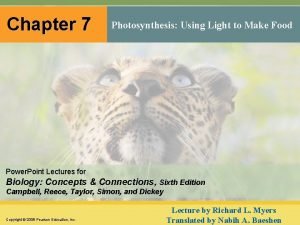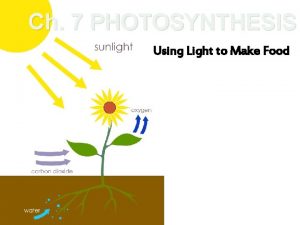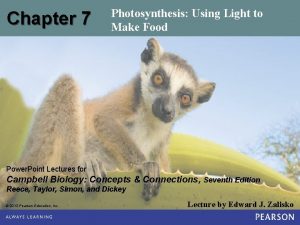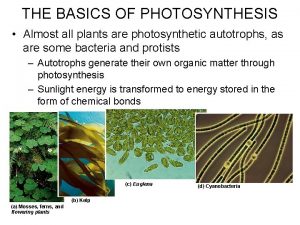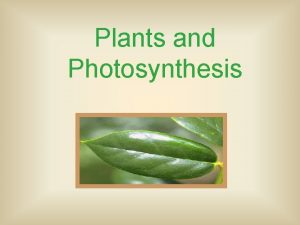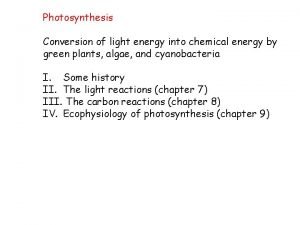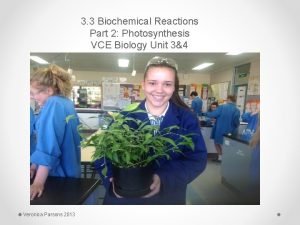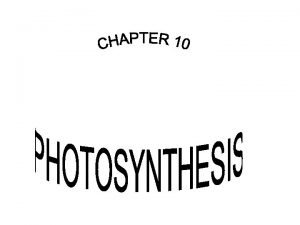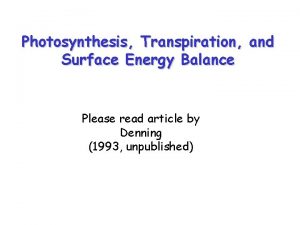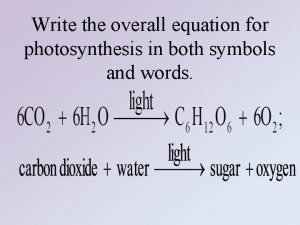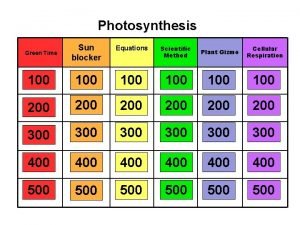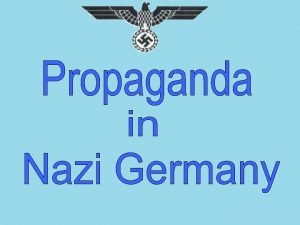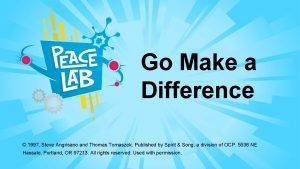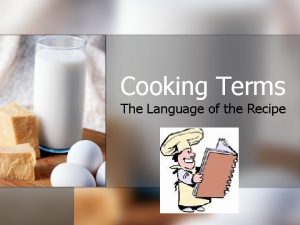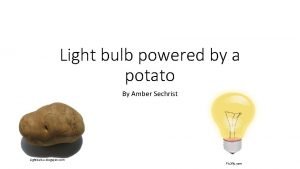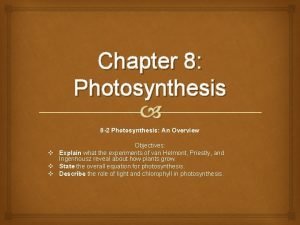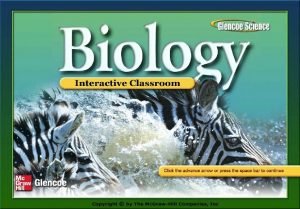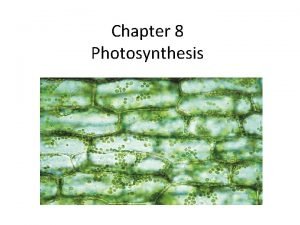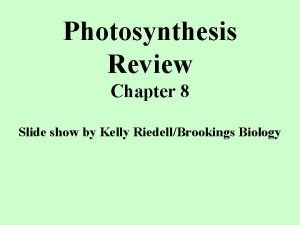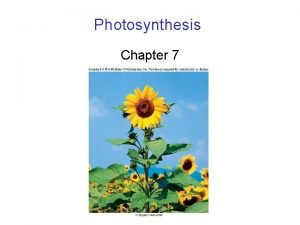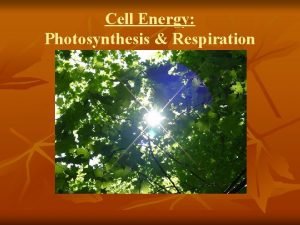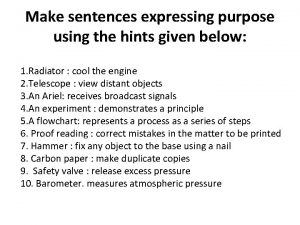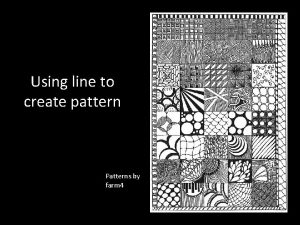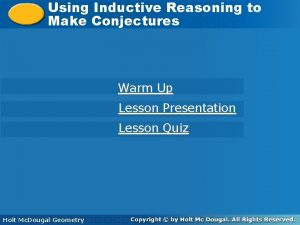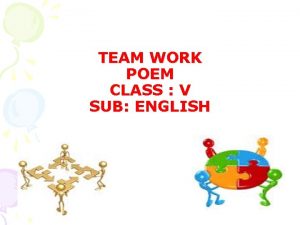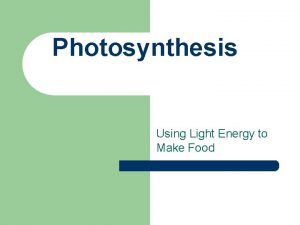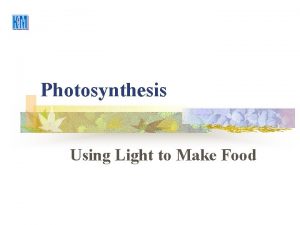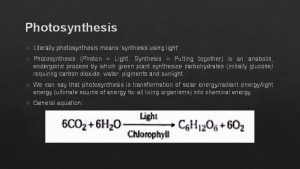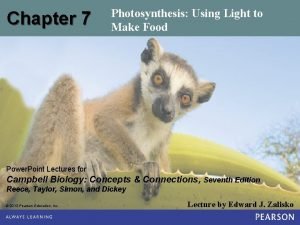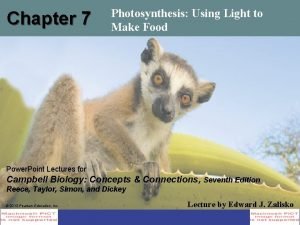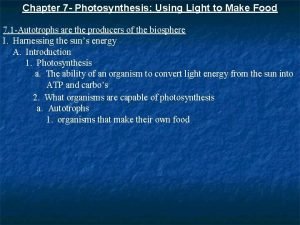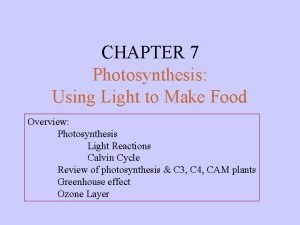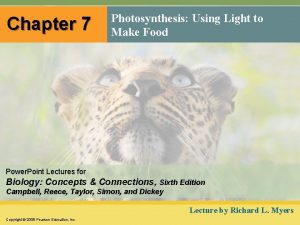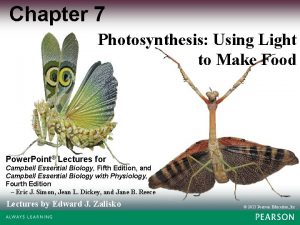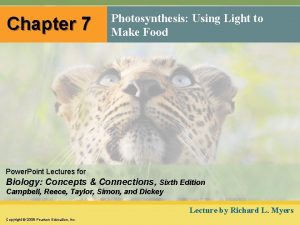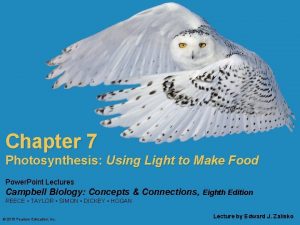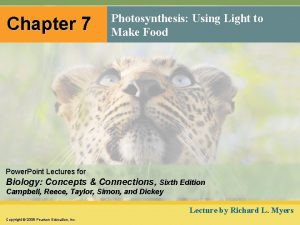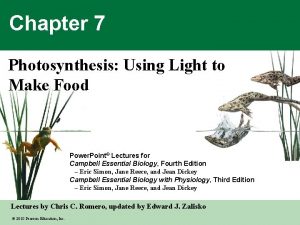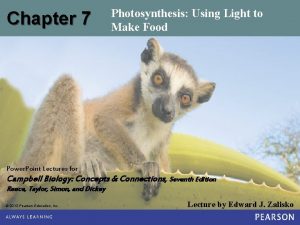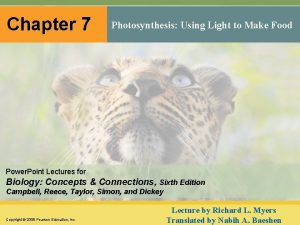Chapter 7 Photosynthesis Using Light to Make Food









































- Slides: 41

Chapter 7 Photosynthesis: Using Light to Make Food 0

DO NOW Write 5 things that you ate in the past 24 hours.

0 • Photosynthesis is the process by which certain organisms use light energy to make sugar and oxygen gas from carbon dioxide and water • http: //www. youtube. com/watch? v=C 1_uez 5 WX 1 o Light energy 6 CO 2 + Carbon dioxide 6 H 2 O Water C 6 H 12 O 6 PHOTOSYNTHESIS Glucose + 6 O 2 Oxygen gas

0 • As the human demand for energy grows o Fossil fuel supplies are dwindling • Energy plantations o Are being planted to serve as a renewable energy source

AN OVERVIEW OF PHOTOSYNTHESIS 0 7. 1 Autotrophs are the producers of the biosphere • Plants are autotrophs o Producing their own food and sustaining themselves without eating other organisms

• Producers o Are autotrophs. o Manufacture the biosphere's food supply. o Make organic food molecules from simple materials. o Sustain themselves without eating. • Consumer o Must eat in order to survive. raw

0 • Plants, algae, and some bacteria are photoautotrophs o Produce organic molecules from inorganic molecules. o Utilize light as their energy source Figure 7. 1 A–D

7. 2 Photosynthesis occurs in chloroplasts • In plants, photosynthesis occurs primarily in the leaves. Mesophyll Cell Leaf Cross Section Leaf Mesophyll LM 2, 600 Chloroplast Vein Stoma CO 2 Chloroplast Outer membrane TEM 9, 750 Grana Figure 7. 2 Stroma Inner membrane Stroma Intermembrane space Granum Thylakoid space

• Stomata (Stoma)-tiny pores on the underside of a leaf that allow carbon dioxide, oxygen, and water to enter/exit. • Mesophyll-green tissue on the interior of the leaf • Chloroplast-where photosynthesis occurs • Chlorophyll-light-absorbing pigment

• Chloroplasts o Composed of two membranes with an intermembrane space o Stroma- Thick fluid where sugars are made o Thylakoid Membrane- system of interconnected membranous sacs. where chlorophyll is found o Grana- disklike membranous sacs arranged in stacks.


7. 3 Plants produce O 2 gas by splitting water • The oxygen released into the air as a product of photosynthesis comes from water. Experiment 1 6 CO 2 + 12 H 2 O Experiment 2 6 CO 2 + 12 H 2 O Products: C 6 H 12 O 6 + 6 H 2 O + 6 O 2 Labeled 6 CO 2 Reactants: Figure 7. 3 A–C C 6 H 12 O 6 + 6 H 2 O + 6 O 2 Not labeled C 6 H 12 O 6 12 H 2 O 6 O 2

0 7. 4 Photosynthesis is a redox process, as is cellular respiration • In photosynthesis H 2 O is oxidized and CO 2 is reduced • Light is the source of energy that provides the boost for electrons during photosynthesis Reduction 6 CO 2 6 H 2 O C 6 H 12 O 6 O 2 6 Oxidation Figure 7. 4 A, B C 6 H 12 O 6 O 2 6 6 CO 2 6 H 2 O Reduction

0 7. 5 Overview: Photosynthesis occurs in two stages linked by ATP and NADPH • The complete process of photosynthesis consists of two linked sets of reactions o The light reactions and the Calvin cycle

• Light Reactions o Occurs in the thylakoid membrane o Convert light energy to chemical energy produce O 2 gas as a waste product o ATP, NADPH, O 2 are produced and

• Calvin Cycle o Occurs in the stroma o Cyclic series of reactions that assemble sugar molecules using CO 2 and the energy-containing products of the light reactions. o Glucose, ADP, NADP+ are produced. o Carbon Fixation- occurs when carbon and oxygen from CO 2 are incorporated into an organic molecule.

0 • The light reactions o o o Convert light energy to chemical energy and produce O 2 The Calvin cycle assembles sugar molecules from CO 2 Using ATP and NADPH from the light reactions H 2 O CO 2 Chloroplast Light NADP+ ADP +P LIGHT REACTIONS (in thylakoids) Electrons Figure 7. 5 O CALVIN CYCLE (in stroma) ATP NADPH Sugar

THE LIGHT REACTIONS: CONVERTING SOLAR ENERGY TO CHEMICAL ENERGY 0 7. 6 Visible radiation drives the light reactions • Certain wavelengths of visible light, absorbed by pigments, drive the light reactions of photosynthesis Increasing energy 10– 5 nm 10– 3 nm Gamma rays X-rays 1 nm 103 nm UV 1 m 106 nm Microwaves Infrared 103 m Radio waves Light Visible light 380 400 500 600 700 Reflected light 750 Wavelength (nm) 650 nm Figure 7. 6 A, B Chloroplast Absorbed light Transmitted light

• Electromagnetic Energy- energy that travels in waves. o Ex. Sunlight • Chlorophyll a-Participates directly in the light reactions. o Ex. Most plants are green because Chlorophyll a reflects green light. • Chlorophyll b-Passes absorbed energy to chlorophyll a. • Photon-fixed quantity of light energy

0 7. 7 Photosystems capture solar power • Thylakoid membranes contain multiple photosystems, that absorb light energy, which excites electrons Figure 7. 7 A

0 • Each photosystem consists of o Light-harvesting complexes of pigments o A reaction center with a primary electron acceptor that receives excited electrons from a reaction-center chlorophyll § The reaction centers of photosystem I and II absorb slightly different wavelengths of light. e– Excited state Photosystem Light-harvesting Reaction Photon complexes center Heat Energy of Photon electron Figure 7. 7 B, C Photon (fluorescence) Ground state Chlorophyll molecule Thylakoid membrane Primary electron acceptor To electron transport chain e– Transfer of energy Chlorophyll a molecule Pigment molecules

0 7. 8 In the light reactions, electron transport chains generate ATP and NADPH • Two connected photosystems absorb photons of light and transfer the energy to chlorophyll. • Electrons removed from water molecules pass from photosystem II to photosystem I to NADP+.

• The excited electrons o Are passed from the primary electron acceptor to electron transport chains Photon Photosystem II Stroma Photosystem I NADP+ + H+ 1 6 e– 2 e– Thylakoid membrane 4 5 P 700 P 680 Thylakoid space Figure 7. 8 A 3 H 2 O 1 O 2 + 2 H+ 2 Electron transport chain Provides energy for synthesis of by chemiosmosis ATP NADPH

• Electrons shuttle from photosystem II to I o Providing energy to make ATP • Electrons from photosystem I o Reduce NADP+ to NADPH e– ATP e– e– NADPH e– e– Mill makes ATP e– Photon Figure 7. 8 B Photosystem II Photosystem I

• As a result of the cascade of electrons down the electron transport chains of the light reactions, NADP+ is reduced to NADPH. • Photosystem II regains electrons by splitting water, releasing O 2 • Water molecules NADP+ which is reduced to NADPH, the source of electrons in the Calvin Cycle

7. 9 Chemiosmosis powers ATP synthesis in the light reactions • The electron transport chain pumps H+ into the thylakoid space • The diffusion of H+ back across the membrane through ATP synthase powers the phosphorylation of ADP to produce ATP (photophosphorylation)

• The final electron acceptor in oxidative phosphorylation is O 2, while it is NADP+ in photophosphorylation. Chloroplast Stroma (low H+ concentration) H+ Light ADP + H+ NADP+ + H+ P H+ NADPH H+ Thylakoid membrane H 2 O 1 2 H+ O 2 2+ H+ Photosystem II Thylakoid space (high H+ concentration) Figure 7. 9 H+ Electron transport chain H+ H+ Photosystem I H+ H+ H+ ATP synthase ATP

• Chemiosmosis • http: //www. youtube. com/watch? v=e. Y 1 Reqi. Yw. Y s • Transition • http: //www. youtube. com/watch? v=Bdcf. Hn 0 z. AU&feature=related

THE CALVIN CYCLE: CONVERTING CO 2 TO SUGARS 7. 10 ATP and NADPH power sugar synthesis in the Calvin cycle • The Calvin cycle occurs in the chloroplast’s stroma Input CO 2 ATP NADPH CALVIN CYCLE Figure 7. 10 A Output: G 3 P

• The cycle constructs G 3 P, an energy-rich molecule that a plant cell can then use to make glucose or other organic molecules. 1 Input: 3 CO 2 1 3 P P P 6 Ru. BP 2 3 -PGA 6 3 ADP 3 ATP CALVIN CYCLE 4 6 ADP + 6 NADPH 6 NADP+ 2 3 5 P 6 G 3 P P G 3 P 3 4 Figure 7. 10 B Output: 1 P G 3 P ATP Glucose and other compounds P

PHOTOSYNTHESIS REVIEWED AND EXTENDED 7. 11 Review: Photosynthesis uses light energy to make food molecules • The ultimate source of all the food we eat and the oxygen we breathe is photosynthesis. H 2 O CO 2 Chloroplast Light NADP+ ADP + P Thylakoid membranes Photosystem II Electron transport chains Photosystem I CALVIN CYCLE (in stroma) Figure 7. 11 LIGHT REACTIONS 3 -PGA ATP NADPH O 2 RUBP Stroma G 3 P Sugars CALVIN CYCLE Cellular respiratio Cellulose Starch Other org compoun

7. 12 C 4 and CAM plants have special adaptations that save water • In C 3 plants a drop in CO 2 and rise in O 2 when stomata close on hot dry days divert the Calvin cycle to photorespiration • C 4 and CAM plants help the plant conserve water and synthesize glucose efficiently under hot, dry conditions.

• C 4 plants first fix CO 2 into a four-carbon compound that provides CO 2 to the Calvin cycle Mesophyll cell CO 2 4 -C compound CO 2 CALVIN CYCLE Sugarcane Figure 7. 12 (left half) Bundle-sheath cell 3 -C sugar C 4 plant

• CAM plants open their stomata at night making a four-carbon compound used as a CO 2 source during the day CO 2 Night 4 -C compound CO 2 CALVIN CYCLE 3 -C sugar Figure 7. 12 (right half) CAM plant Day Pineapple

• Do photosynthesizing plants have mitochondria? Why or why not? • Yes, to supply the plant with the ATP needed to power various cell activities.

PHOTOSYNTHESIS, SOLAR RADIATION, AND EARTH’S ATMOSPHERE CONNECTION 7. 13 Photosynthesis moderates global warming • Greenhouses used to grow plants o Trap solar radiation, raising the temperature inside Figure 7. 13 A

• Excess CO 2 in the atmosphere is contributing to global warming Some heat energy escapes into space Sunlight ATMOSPHERE Radiant heat trapped by CO 2 and other gases Figure 7. 13 B

• Photosynthesis, which removes CO 2 from the atmosphere, moderates this warming

TALKING ABOUT SCIENCE 7. 14 Mario Molina talks about Earth’s protective ozone layer Figure 7. 14 A

• Solar radiation converts O 2 high in the atmosphere to ozone (O 3) o Which shields organisms on the Earth’s surface from the damaging UV radiation

• Industrial chemicals called CFCs (chlorofluorocarbons) have caused dangerous thinning of the ozone layer o But international restrictions on CFC use are allowing recovery Southern tip of South America Antarctica Figure 7. 14 B
 The process of photosynthesis
The process of photosynthesis Photosynthesis using light to make food
Photosynthesis using light to make food Using light to make food
Using light to make food Light light light chapter 23
Light light light chapter 23 Into the light chapter 22
Into the light chapter 22 Chapter 22
Chapter 22 Green plants make their own food by photosynthesis
Green plants make their own food by photosynthesis Green plants make their own food by photosynthesis
Green plants make their own food by photosynthesis Inputs of light reactions in photosynthesis
Inputs of light reactions in photosynthesis Light reactions photosynthesis
Light reactions photosynthesis Chemical form of energy
Chemical form of energy How to measure photosynthesis
How to measure photosynthesis Electron transport in photosynthesis
Electron transport in photosynthesis Structure of chlorophyll
Structure of chlorophyll Photosynthesis transforms light energy into chemical energy
Photosynthesis transforms light energy into chemical energy Unit 2 food food food
Unit 2 food food food Food chain sequence
Food chain sequence Overall equation for photosynthesis
Overall equation for photosynthesis The food that plants produce during photosynthesis is
The food that plants produce during photosynthesis is Food web photosynthesis
Food web photosynthesis Make the lie big
Make the lie big Steve angrisano go make a difference
Steve angrisano go make a difference Make the lie big, make it simple
Make the lie big, make it simple Language
Language How to make a potato powered light bulb
How to make a potato powered light bulb Put out that light
Put out that light Membrane bound organelles
Membrane bound organelles Or the bending of light and the bouncing off of light
Or the bending of light and the bouncing off of light Which materials let light through
Which materials let light through Section 8-2 photosynthesis an overview answers
Section 8-2 photosynthesis an overview answers Cellular energy section 2 photosynthesis answer key
Cellular energy section 2 photosynthesis answer key Chapter 9 lesson 2 photosynthesis an overview
Chapter 9 lesson 2 photosynthesis an overview Chapter 8 photosynthesis vocabulary review
Chapter 8 photosynthesis vocabulary review Chapter 8 photosynthesis vocabulary review
Chapter 8 photosynthesis vocabulary review Chapter 7 photosynthesis
Chapter 7 photosynthesis How do plants get glucose
How do plants get glucose Make sentences using the past simple and past continuous
Make sentences using the past simple and past continuous Write 2 sentences by using expressing purpose
Write 2 sentences by using expressing purpose Making predictions with experimental probability
Making predictions with experimental probability Simple line patterns
Simple line patterns Using inductive reasoning to make conjectures answers
Using inductive reasoning to make conjectures answers Short tube or stick carried in relay race
Short tube or stick carried in relay race
